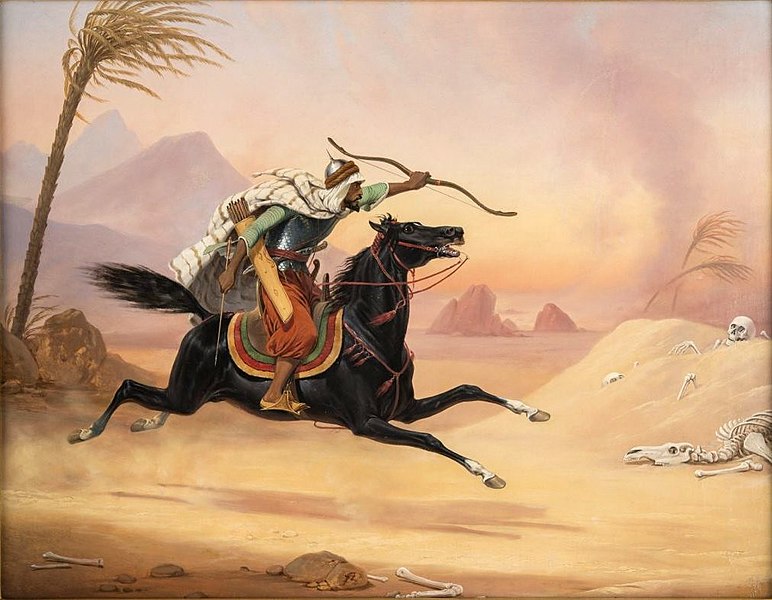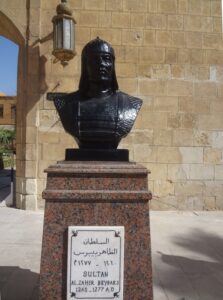ASTANA – From humble beginnings as a slave boy to becoming one of the most eminent Mamluk sultans, the extraordinary story of Sultan Beibars is celebrated in Kazakhstan 800 years after his birth as an example of how one man can turn a region filled with ongoing political rivalry and warfare into a prosperous place.

Mamluks formed the military apparatus of 13th-16th century Egypt and Syria mostly made up of slaves of Turkik origin. Photo credit: “Chivalry” (Al-Furussiyyah) 1836 painting by Janvier Suchodolski in National Museum of Poland/medievalreporter.com.
The man who would become the ruler of the Mamluks in Egypt and Syria was born in 1223. His rise was an extraordinary feat for a man who began his life as a slave boy of Kipchak origin, born in what was known as Desht-i-Kipchak located in the modern territory of Kazakhstan between the Yedil (Volga) and Zhaiyk (Ural) rivers.
In 1242, Mongols invaded the territories of Desht-i-Kipchak, and Beibars was taken as a slave for further training in the service of the Egyptian emir Aidakin al-Bundukdar. He was a sturdy and strong young man. Representatives of the Egyptian nobility usually ransomed such slaves.
Soon Aidakin al-Bundukdar fell out of favor with Sultan As-Salih II, who confiscated all his slaves. A skillful and courageous trainee, Beibars very soon caught the attention of Sultan Al-Salih, who consequently appointed him as the commander of his bodyguards.
A hardy warrior
Beibars built his military career through a series of successful battles under Turan Shah. One of his major military victories was at the city of Al-Mansurah in 1250 against the crusaders’ army led by Louis IX of France.

Bronze bust of Sultan Beibars in Cairo, at the National Military Museum. Photo credit: Ahmed Y.Elmamlouk/wikipedia.org
According to historical records, in the aftermath of the battle, King Louis IX, both of his brothers, many aristocrats, and nobles were taken prisoner, many fled, and the rest had no choice but to surrender. The Mamluks sank around 4,000 crusader ships on the Nile River. Later, King Louis IX was ransomed for a large sum of money.
With the death of Turan Shah in 1250, a shuffle of rulers began that lasted until Sultan Qutuz came to the throne in 1259. During this period, Beibars, along with other Mamluks, fled to Syria for the safety of their lives. As Sultan Qutuz ascended the throne, he gave security guarantees to Mamluks to return to Egypt.
Under Qutuz’s rule, Beibars defeated the Mongols and captured the city of Kit Buga in 1260. For his remarkable victory, Beibars expected to be rewarded by Qutuz. However, the sultan was hesitant, fearing Beibars’s ambitions. An enraged Beibars killed Qutuz on his way back to Cairo and seized power to become the new ruler of the Mamluks.
A powerful ruler
In the 17 years of his reign, from 1260 until 1277, Beibars aspired to build a civilizational model in his country and was largely untroubled by outside threats.
Beibars had fought dozens of battles: some against the Mongol empire, others against the crusaders. Having led the armed resistance against the invaders, Beibars united Muslim Syria and Egypt into a single state.

The Mamluks defeated the crusaders at the disaster of Mari in 1266. Photo credit: “Le Livre des Merveilles”, early 15th century. From “Le Royaume Armenien de Cilicie”, Claude Mutafian/wikimedia.org.
In an interview with Newtimes news agency, Kazakh historian Nikolay Lapin said during the rule of Sultan Beibars, the Middle East was shielded against threats from rival civilizations of Mongols and crusaders.
“Let me remind you that Sultan Beibars also became famous for his military actions against numerous crusader attacks in the Middle East. He is one of those who, in fact, stopped the very active Mongol claims to the territory of Egypt. Sultan Beibars carried out reforms within the state and managed to create one of the medieval empires of the time,” said Lapin.

The Mamluks under Beibars (yellow) fought off the Franks and the Mongols during the Ninth Crusade. Photo credit: wikiwand.com.
Continuing on why Sultan Beibars’s legacy remained in the historical memory of the Middle East, Egypt, Syria, Iran, and some European states, Lapin said it was due to his “very powerful activity as he held the throne of the ruler of Egypt.”
“This was the 13th century, a time of great tension and activity throughout the Old World, which was also connected with the Mongol conquests, the birth of the Mongol empire, the waning but still active crusades, and so on,” he added.
In 17 years, Sultan Beibars conquered the towns of Atlit, Haifa, Safed, and Jaffa, conducted almost yearly raids against the crusaders, and engaged in nine battles against the Mongols of Persia.
A man who built prosperous cities
Sultan Beibars remains a noble figure and a source of inspiration for both Kazakhs and Egyptians for his contribution to making the region a wealthy and infrastructurally advanced place. Along with bringing political union to the region, he was credited with creating the most vibrant area of human development back then.

Mausoleum chamber of Sultan Beibars in Al-Zahiriyah Library in Damascus. Photo credit: Francesco Bandarin/wikipedia.org
During his reign, new canals were built and the harbors improved. He established a regular and fast postal service between Cairo and Damascus. In Cairo, a large mosque was built based on his drawings, and a madrasa (school) bore his name. The region became a prosperous place to live.
He is reputed to be a guardian of widows, orphans, the elderly, the destitute, dervishes, and ascetics. Children of people in need studied in his madrasas for free, and orphans were provided with everything they needed at the state’s expense. Locals also studied geography, history, math, astronomy, and other disciplines besides Shariah law.
Beibars died in Damascus, Syria, in 1277. He did not survive the poisoning that is said to have been intended for someone else. He was buried under the dome of the present Madrasa Al-Zahiriyah, which he established under his reign.


